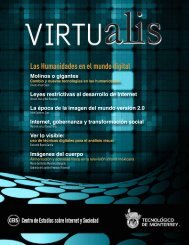P
terranova-network-culture
terranova-network-culture
- No tags were found...
You also want an ePaper? Increase the reach of your titles
YUMPU automatically turns print PDFs into web optimized ePapers that Google loves.
Introduction 3(rather than simply inhibits) social potentials for transformation.In this sense, a network culture is inseparable both from a kind ofnetwork physics (that is physical processes of differentiation andconvergence, emergence and capture, openness and closure, andcoding and overcoding) and a network politics (implying the existenceof an active engagement with the dynamics of information flows).The first chapter is a lengthy engagement with information theorywith the stated intent of understanding more about this mysteriousphysical entity as it has come to pervade the language and practicesof contemporary culture. I will start by freeing up the concept ofinformation from two prejudices that have actually hindered ourunderstanding of informational dynamics: the idea that informationis ‘the content of a communication’; and the notion that informationis ‘immaterial’. This interpretation of information theory (and inparticular of Claude Shannon’s 1948 paper on ‘The MathematicalTheory of Communication’) will play up those aspects of informationthat correspond to or explain the informational dynamics ofcontemporary culture (and hence the field of cultural politics). Ihave thus put forward a series of propositions linking informationtheory to something that we call ‘the cultural politics of information’and have tried to understand how such a shift has transformed andaffected the cultural politics of representation (both linguistic andpolitical). The relationship between physical concepts such as entropyand negentropy, noise and signal, micro and macro, nonlinearity andindeterminacy determines the production of a ‘materialistic’ theoryof information that could help us to make better sense of the ‘chaosof communication’ in which we live.The second chapter discusses the architecture of networks,and more specifically the architecture of the Internet. In thiscase, the Internet is taken as a technical diagram able to supportthe development of an informational space that is driven by thebiophysical tendencies of open systems (such as the tendencytowards divergences, incompatibilities, and rising entropic levels ofrandomness and disorganization). Here I take the Internet to be notsimply a specific medium but a kind of active implementation ofa design technique able to deal with the openness of systems. Thedesign of the Internet (and its technical protocols) prefigured theconstitution of a neo-imperial electronic space, whose main featureis an openness which is also a constitutive tendency to expansion.The chapter explores how the informational dynamics instantiatedby the design philosophy of the Internet is actualized in a series of








